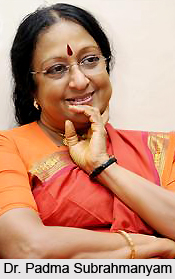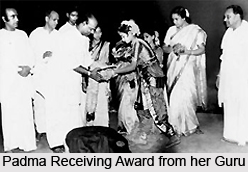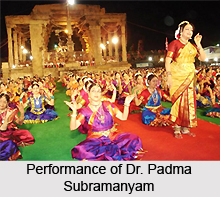 Dr. Padma Subrahmanyam, the legendary Bharatnatyam dancer is a rare combination of a dancer, research scholar, choreographer, music composer & musician, teacher and author. Padma Subramanyam enchants spectators with perfect movements and hand gestures, timing, original ideas and emotes beautifully with her face. She imparts her immense knowledge to others by teaching dance, conducting workshops, giving lectures, doing research and writing articles This multi faceted and talented artist is famous in India as well as abroad, several films and documentaries have been made in her honor by countries like Japan, Australia and Russia.
Dr. Padma Subrahmanyam, the legendary Bharatnatyam dancer is a rare combination of a dancer, research scholar, choreographer, music composer & musician, teacher and author. Padma Subramanyam enchants spectators with perfect movements and hand gestures, timing, original ideas and emotes beautifully with her face. She imparts her immense knowledge to others by teaching dance, conducting workshops, giving lectures, doing research and writing articles This multi faceted and talented artist is famous in India as well as abroad, several films and documentaries have been made in her honor by countries like Japan, Australia and Russia.
This eminent Bharatnatyam Dancer was born on 4th February 1943 in Chennai. She was born to an internationally reputed famous filmmaker, freedom fighter and a parental personality in the cultural field father K. Subramanyam and a music composer, lyricist in Tamil and Sanskrit, dancer, instrumentalist mother Meenakshi. Padma grew up in an environment where both her parents were artistically inclined.
She started to learn dance at `Nrutyodaya` under the guidance of a teacher named Kausalya. "Nrutyodaya" is a dance school that was founded by her father in the year 1942 of which she is the director presently. Later, she came under the wings of guru Vazhuvoor Ramaiah Pillai. Padma Subramanyam`s first public performance known as "Arangetram" (first performance) was in the year 1956. After that there was no looking back. She gave innumerable performances in concerts all over the world. She has had a number of gurus especially during her research- Guru Dandayuthapani Pillai and the various Devadasis from whom she learned ` adavus`, Gowri Ammal from whom she learnt `abhinaya` being some of them. Padma has also trained in music under B.V. Lakshman and Salil Chaudhry.
 She also continued her education side by side. Dr. Padma Subramanyam has a Bachelor`s degree in Music, Master`s in Ethno Musicology and Ph.D in dance from Annamalai University. She did her thesis on `Karanas in Indian dance and sculpture` as a research scholar. Karanas is the basic units of dance. Her research highlighted the fact that the 108 Karanas are actually movements and not just static poses. As she asserts `the twin arts of dance and sculpture developed together in close spiritual association with the concept of the Divine Being himself as a dancer in Tamilnad. The fusion of these two arts dates back to the dawn of our civilization. The figure of a dancer unearthed in Mohenja-daro of proto-historic India explains the genetic relationship between the various dance styles of India. The pose of this icon is still found in the varied dances of our country. Proper preservation of the dance sculptures in the country is an immediate necessity. Spoiling them by whitewashing and covering them by careless constructions should be ruthlessly prohibited`. She has also designed the sculptures of the 108 Karanas of Lord Siva and Goddess Parvati in black granite for the Nataraja temple at Satara in Maharashtra.
She also continued her education side by side. Dr. Padma Subramanyam has a Bachelor`s degree in Music, Master`s in Ethno Musicology and Ph.D in dance from Annamalai University. She did her thesis on `Karanas in Indian dance and sculpture` as a research scholar. Karanas is the basic units of dance. Her research highlighted the fact that the 108 Karanas are actually movements and not just static poses. As she asserts `the twin arts of dance and sculpture developed together in close spiritual association with the concept of the Divine Being himself as a dancer in Tamilnad. The fusion of these two arts dates back to the dawn of our civilization. The figure of a dancer unearthed in Mohenja-daro of proto-historic India explains the genetic relationship between the various dance styles of India. The pose of this icon is still found in the varied dances of our country. Proper preservation of the dance sculptures in the country is an immediate necessity. Spoiling them by whitewashing and covering them by careless constructions should be ruthlessly prohibited`. She has also designed the sculptures of the 108 Karanas of Lord Siva and Goddess Parvati in black granite for the Nataraja temple at Satara in Maharashtra.
Dr. Padma Subramanyam has given several solo and group presentations such as
` Meenakshi Kalyanam`, ` Viralimalai Kuravanji`, `Silappadikaram`, ` Vande Mataram` etc. She has also composed music for most of her compositions and sung for a couple of albums.
 `Pushpanjali` as a dance piece was introduce by her. Padma was the first dancer to use a `meera bhajan` to be scored to suit the grammar of `Pada Varnam`. She has also composed the first Bengali Varnam, of which Salil Chaudhury was the lyricist. She has reactivated the mono acting technique in her dance dramas. She has authored numerous articles, research papers, books and travelogues to her credit like `Bharata`s Art - then and now`, `Bharatakkalai Kotpadu` in Tamil, `Natya Sastra and National Unity` and `Kanchi Mahaswami`s Vision of Asian Culture`. She has written many articles that have been compiled as "Legacy of a Legend".
`Pushpanjali` as a dance piece was introduce by her. Padma was the first dancer to use a `meera bhajan` to be scored to suit the grammar of `Pada Varnam`. She has also composed the first Bengali Varnam, of which Salil Chaudhury was the lyricist. She has reactivated the mono acting technique in her dance dramas. She has authored numerous articles, research papers, books and travelogues to her credit like `Bharata`s Art - then and now`, `Bharatakkalai Kotpadu` in Tamil, `Natya Sastra and National Unity` and `Kanchi Mahaswami`s Vision of Asian Culture`. She has written many articles that have been compiled as "Legacy of a Legend".
This versatile dancer Padma Subramanyam has received many awards and honors to her credit including `Padma Bhushan` in 1983, `Padmashri` in 1981, `Sangeet Natak Akademi Award`in 1983, `Kalaimamani Award` from Govt. of Tamilnadu, `Kalidas Samman` from Govt. of Madhya Pradesh, `Nada Brahmam` from Narada Gana Sabha in Chennai, `Bharata Sastra Rakshamani` and Nehru Award in1983 of the Soviet Union so on. Padma Subramanyam has also received the prestigious `Fukuoka Asian Cultural Prize` from Japan for her contribution to development and harmony in Asia. She has served as a non-official member of the Indo-Sub-commission for education and culture.



















